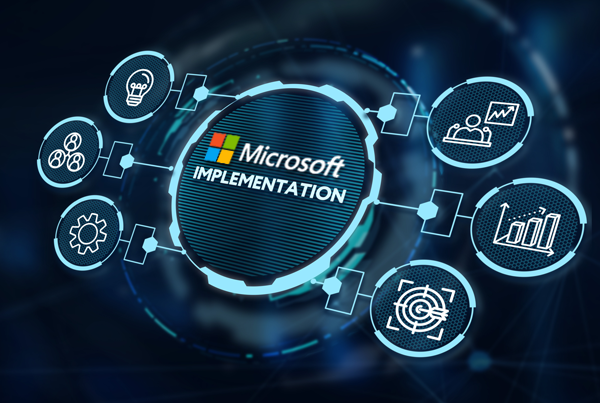ARTICLE | 5 MIN READ
Top Tips for Choosing & Implementing New Software
Easy tips and tricks to navigate your next software purchase and implementation.

Whether you’re considering an expense management tool for your employees or a completely new ERP or CRM system, you’re bound to go through the process of purchasing new technology for your business. Here are our top tips and insights for navigating the process.
How to Find the Right Product and Vendor
When you begin the journey to purchase new software, you’ll likely follow a process that looks like this:
Step 1: Research
Before you start looking at software or talking to providers, it’s important to understand your needs, your budget, and your expectations. You should be able to answer all of the following questions before making a purchase:
- What are the biggest problems we’re trying to solve?
- What things do we want most from a new solution?
- What parts of our business does the software need to manage?
- What’s our budget for the initial purchase? For ongoing costs and maintenance?
- When do we want a new tool in place?
- Do we want to deploy it on our servers or in the cloud?
- Do we want to connect it to any of our other business tools?
- Can our team handle any of the setup?
- What do we want from the software provider?
Don’t forget about your team during the research phase. Make sure you have a good understanding of what they do daily. Get their thoughts on their biggest pain points and what they’d most like to change about your existing system.
Now that you’ve done your due diligence and have a clear picture of your needs, it’s time to start looking for a solution to match.
Step 2: Discovery
Some software developers sell software directly to consumers, but others like Microsoft and Sage use third-party vendors for implementation. You may hear these companies called resellers, partners, ISPs (independent software providers), or VARs (value-added resellers). This is an opportunity to learn about the provider, not just the software.
Your partner will be responsible for software setup as well as ongoing system maintenance and support. When you first connect with a software provider, they’ll likely want an introductory meeting to learn about you and your business. They will dig into your roadblocks during this meeting and understand what you hope to achieve by purchasing new software. They might also ask about your budget and timeline expectations.
Each software partner offers a unique set of services and specializations. Here are some questions that can help you identify the best partner for your business.
- How long have you been in business?
- How much experience do you have working with this product?
- What other capabilities do you have? Do you offer other products or services?
- How much experience do you have working with companies like ours?
- Do you have any references we can contact?
- Describe your implementation process. What do you handle, and what will our team be responsible for?
- How does training work?
- What resources do you offer after implementation? What is the cost?
- How does support work, and what is the cost?
- How often is the software updated?
- How do you handle upgrades?
- How do you evaluate and plan for new features? Do you share your product roadmap with customers?
- What’s the long-term strategy for your business and the product?
- What’s your ownership structure?
- What’s your culture like?
Step 3: Demo
A demo is your opportunity to see the software in action. It should be personalized to you and your business based on what you discussed with the software provider during discovery. It should be a live demo (not screenshots or a recorded video), and you should have the opportunity to ask questions and dig further into any component of the software.
Make sure all the key players participate in the demo:
- Search team: anyone helping with the research and selection process
- Decision maker: the person responsible for approving the purchase and budget
- Key users: a few people who use your current software daily
- Technical team: your IT team or anyone involved in the technical setup of the new tool
Evaluate the software using the list of criteria you developed during the research stage:
- Does the product meet your top requirements?
- What’s missing, and how critical is that functionality to you?
- Are there areas where you need to dig deeper?
- Do you feel confident your team will use the product?
- Do you feel confident in the vendor?
Step 4: Purchase
Before signing on the dotted line, break down all the pricing details. In addition to the software cost, make sure you know the cost of the associated services (implementation, training, etc.) and ongoing support and maintenance costs. It’s also important to know what’s covered in the vendor’s implementation and support services and what isn’t.

Top Tips for a Successful Implementation
The key to a successful implementation is to make sure everyone is involved. Your end-users and software partner should work together to tailor the solution to your business:
- Take ownership of your tasks. Understand your responsibilities versus the software provider’s responsibilities.
- Track your progress. Know your implementation timeline and key milestones, and don’t leave things to the last minute.
- Appoint a project manager. Select a team member to manage project details. Ensure this person is equipped to make decisions or seek direction from leadership when needed.
- Establish an implementation team. Pick employees who understand your processes and can help decide how the software should be set up and those who will become end-users. Give each person a specific role, like report setup or training.
- Decide as much as possible up-front. Don’t gloss over setup decisions thinking you’ll figure it out later—you may be locking yourself into something that will negatively impact your team and your business. Be sure you understand your reasoning so you can make the best decisions.
- Take time to tidy up data. If you’re going to be loading information into your new software, take the time to clean up your legacy data so you can start with a clean slate.
- Do training during the setup process. Don’t wait until you’re live on the new software to learn how to use it. Build excitement among your team as you prepare to launch the solution.
- Test the new software before going live. Practice day-to-day scenarios with your team to learn how the software works and how to use it. This is also a great time to make adjustments.
How to Set Yourself Up for Ongoing Success
Implementation is a big hurdle to clear, but your journey with your new software is just beginning. It will take ongoing effort to get the most out of your new tool and ensure it is still serving your needs as your business grows.
Top Tips for Ongoing Success
- Establish internal support. Establish a resource at your company to provide support and answer questions before sending your team to the vendor for help.
- Understand what’s covered by your monthly/annual fee. You’re paying good money each year for your software. Make sure you know what that money is going towards and take advantage of all the included benefits.
- Upgrade your software regularly. Keep your software up to date to get the latest features and the best support. This also reduces your overall upgrade costs.
- Engage with other users. No one understands the software better than the people who use it daily for their businesses. Other users will have tips and tricks, best practices, and answers to questions that can help you and your business.
- Have an onboarding plan. Ensure new employees are properly introduced to and trained on your software so they have all the tools they need to do their jobs.
- Take advantage of learning opportunities. Send users to regular training sessions or other conferences and events hosted by your software vendor. This keeps their skills sharp and introduces them to new processes or features—knowledge they can bring back to the rest of your team. Regular training also ensures you’re using the software to its fullest potential and getting the most out of your investment.
- Keep your vendor in the loop. As your business changes, so will your needs. Your software vendor can help you adapt your solution over time.
- Give feedback. Software vendors rely on user feedback to make changes or improvements to their software and develop new features. You can have input in the direction of the software you’re using by providing product suggestions and feedback to the vendor.
Investing in New Technology
Technology is an essential component of your business strategy. Not every tool may require the same level of research or involve a lengthy implementation, but it’s important to think of technology as an investment. Take the necessary steps to invest in the right places and nurture your investment once you do. The right tools can support your business and drive you toward your goals, while the wrong tools can stand in your way.


